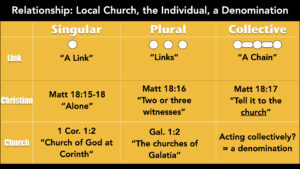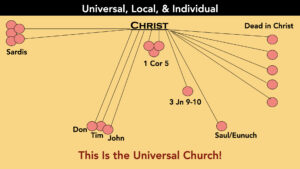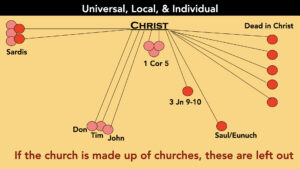Podcast: Download (40.4MB)
The Rise of the Denomination
The Relationship between the Universal Church, the Local Church, and the Individual
Introduction: A quarter is a denomination of a dollar. A dime is a denomination of a dollar, as is a nickel or a penny. For the past 400 years, most religious people have viewed God’s church as made up of various churches – each church being a “denomination” of the whole body of Christ.
Even among churches of Christ, members often speak of “the church of Christ” as a group of churches that can be visibly identified throughout the world. Many think that such an understanding of the church is insignificant and does not carry any consequences. That could not be further from the truth. The denominational concepts and terminology regularly repeated among Christians seriously affects the way a local church and an individual Christian goes about the Lord’s work.
In this lesson, we will clearly draw these distinctions and expose the dangers.
- Quick Reminders
- “Church” is a non-religious term for “a bunch of people.”
- “Universal” church is a shorthand way of referring to all the saved dead or alive, as stated in Hebrews 12:23, “to the assembly [ekklesia] of the firstborn who are enrolled in heaven…”
- “Local” church is a local group of Christians in a particular location – “the church of God at Corinth” – who have agreed to work together in God’s kingdom.
- Exposing Denominational Practices
- William Banowsky, former president of Pepperdine University and preacher in the 1960’s: “The lecturers came to desire a missionary procedure which would more effectively involve the hundreds of small congregations. But they also sought a program whose scope would be more far-reaching than even the best, but isolated efforts of any one large congregation. They could not resist the temptation to shop about and contrast their plight with the obvious strong points in denominational machinery. Thus, they sought for some practical, scriptural means of brotherhood-wide control.”
- An easy way to show this error is to compare it to the links of a chain. It is possible to have a single link, or a group of links independent of one another, or a chain where the links function as a unit.
- Now look at Matthew 18:15-17. A Christian may act alone, or a plurality of Christians may act in their own individual capacity (Paul, Silas, Timothy), or the church may act collectively.
- Now take it to the next level. The Bible speaks of an individual church (1 Cor. 1:2). The Bible also speaks of a plurality of churches in a particular region (Galatians 1:2. But the Bible never mentions a plurality of Churches operating collectively.
- This last arrangement, of which the Bible does not speak, is what is known as a denomination: a plurality of churches operating collectively. Thus the idea spoken of by William Banowsky and practiced broadly from the 1950’s until today.

- To further illustrate the seriousness of this pattern, consider the departure in the second century. Strong “Bishops” rose up among elderships in local churches, eventually taking control of smaller rural churches to protect them against gnosticism. By 325 AD, 318 Bishops gathered to solidify a unified doctrine among churches. While unity among churches may sound good, the result is that doctrine is dictated by a group of men instead of by the individual and collective study of the scriptures in each local body. The result was eventually a pope, cardinals, bishops, and priests that exercise doctrinal control.
- Alexander Campbell wrote: “The church…is not one congregation or assembly, but the congregation of Christ, composed of Christ, composed of all the individual congregations on earth.”
“Every individual church on earth stands to the whole church of Christ as one individual man to one particular church.” - Though we see this error to be obvious when it was played out in the formation of the Roman Catholic Church, churches of Christ have repeatedly practiced the same thing on a smaller scale. Even Alexander Campbell did not make the proper differentiation and aided in the formation of the American Missionary Society in 1851.
- Present day churches still do this same in various ways: elders of a local church plant a second church and maintain oversight of it until it has its own leaders.
- A local church urges other local churches to surrender part of the moneys to their oversight for a particular evangelistic or charitable cause. Often referred to as a “sponsoring church.” A violation of 1 Peter 5:1, “Shepherd the flock among you.”
- When it was going over this principle many years ago in a Bible class, a woman replied, “Is this just about money?!” No, it is not just about money, it is about creating a full blown denomination. It is the same principle as the Roman Catholic Church.
- Seeing the Roots of a Denomination
- We have repeatedly noted the obvious biblical difference between a local church and the universal church, that is, all the saved whether dead or a live. But human traditions have created a third option, a visible group of churches on earth that is designated by a particular name or title. Thus, the Methodist Church is made up of Methodist churches. Or, the Church of Christ is made up of churches of Christ.
- While there is nothing wrong with a local church giving a descriptive name on their sign, these names are most often understood as being part of a collection of churches instead of a collection of individual Christians.
- A young man I taught the other day believed that since our sign said, Church of Christ, we were a local church part of a larger group of churches called “Church of Christ.” It was nearly impossible for me to explain the difference:
- Me: “We are not “Church of Christ. We are not part of a denomination. We are just a group of Christians.”
- Answer: “Well then, why is Church of Christ on your sign?”
- I finally said, “‘Church’ means a group of Christians. Thus, a group of Christians following Christ. If we just put, ‘Christians at Woodland Hills meets here,’ would that help you understand?”
- Answer: “I like that. That makes sense.”
- The following charts will help us understand the error of seeing churches within a church, the denominational concept.
- We begin with a Christian named Tim. That he is a Christian and a part of the universal church is evident because he is in fellowship with Christ. All that he does is because of his allegiance to Christ.
- In the second chart we see another Christian named Don. Don also is in fellowship with Christ and lives his life in allegiance to Christ. That Don’s circle overlaps with Tim’s indicates that these two Christians do certain things together in serving Christ. There is not a local church yet, and they may not even be in the same city or country. But some of the things they do for Christ is a joint effort (like Paul & Silas working together in the gospel).
- The third chart adds another Christian named John who happens to join with Tim and Don in serving Christ. At this point, these three agree to work together as a local church like we see in the NT. Their agreement has to do with what Christ has asked a local group of Christians to do together: pool resources, share in teaching the gospel, worship together, and have a common allegiance to Christ. These three may or may not agree on everything in the Bible, but they are working on the “unity of the faith.”
- In the fourth chart we add another local church. This is a church like Corinth in which at least one of the members is not in fellowship with Christ. He erroneously is being included in the local church, but is not in the universal church. Because of sin, he is not in fellowship with Christ.
- The fifth chart adds another person who is in fellowship with Christ (in the universal church), but he is not in a local church because he has been excluded by Diotrephes (3 John 9-10). Those who participated with Diotrephes may have thought they were in fellowship with Christ because they were in a local church, but this is not so.
- The sixth chart adds Christians like Saul or the Ethiopian eunuch, who though they were in fellowship with Christ (in the universal church), they had not yet been able to join with a local church. The Bible teaches that this should be a temporary condition, but it does exist.
- The seventh chart adds another local church like the one at Sardis (Rev. 3:1-4). It seems that the majority of Christians in this church were not in fellowship with Christ. They had a name they were alive, but they were dead. There doesn’t seem to be any immorality here that needs to be corrected, it is just that they do not have their full allegiance to Christ. However, there are a “few” Christians in this church who are still in fellowship with Christ.
- The final chart adds those Christians as in 1 Thessalonians 4:13-17 who are dead. They are no longer in a local church, but they are with Christ and therefore in the universal church. They are still saved.
- Now notice the chart as a whole. This is the universal church – all those with a line to Christ and thus in fellowship with Christ. Some are in a local church, but some are not either because it isn’t yet possible or because they are dead.

- However, if the universal church is made up of churches, or if there is any concept of a church made up of churches, notice those who are left out! Saul, the Eunuch, the ones excluded by Diotrephes, the minority at Sardis, and the dead in Christ.

- Conclusion: Why Humans Have Lobbied for a Collection of Churches
- Unity of doctrine and beliefs worldwide. (Unity! Isn’t that what Jesus prayed for?)
- A visible unity of churches in order to make a greater impact on the world.
- The ability to make a larger financial impact by pooling money from many churches in order to do things that one local church would be able to do.
- Brotherhood control in order to limit false doctrines from invading and taking over churches. (“Brotherhood magazines”)
- Other than the blatant lack of scriptural authority for the above, what is not said is that for the above to take place, someone or ones must be in control!
Berry Kercheville
Acknowledgement: The material in this lesson is based heavily on “Fellowship with God and His People” by Samuel Dawson. The charts are Samuel Dawson’s.
